简单句并列句以及复合句
- 格式:docx
- 大小:31.69 KB
- 文档页数:4
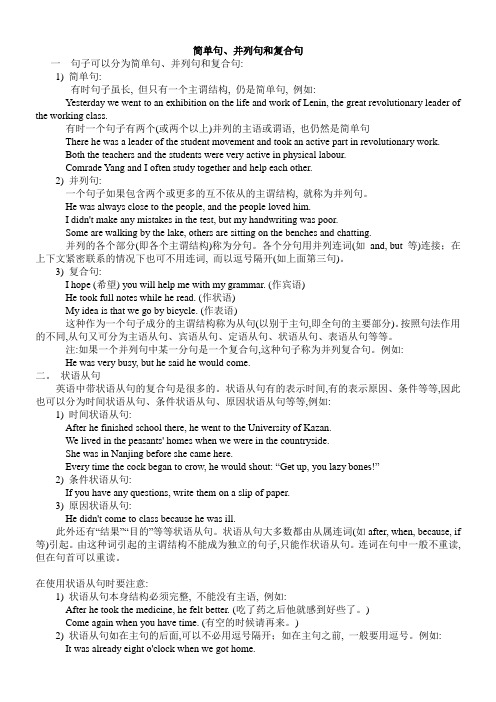
简单句、并列句和复合句一句子可以分为简单句、并列句和复合句:1) 简单句:有时句子虽长, 但只有一个主谓结构, 仍是简单句, 例如:Yesterday we went to an exhibition on the life and work of Lenin, the great revolutionary leader of the working class.有时一个句子有两个(或两个以上)并列的主语或谓语, 也仍然是简单句There he was a leader of the student movement and took an active part in revolutionary work.Both the teachers and the students were very active in physical labour.Comrade Yang and I often study together and help each other.2) 并列句:一个句子如果包含两个或更多的互不依从的主谓结构, 就称为并列句。
He was always close to the people, and the people loved him.I didn't make any mistakes in the test, but my handwriting was poor.Some are walking by the lake, others are sitting on the benches and chatting.并列的各个部分(即各个主谓结构)称为分句。
各个分句用并列连词(如and, but 等)连接;在上下文紧密联系的情况下也可不用连词, 而以逗号隔开(如上面第三句)。
3) 复合句:I hope (希望) you will help me with my grammar. (作宾语)He took full notes while he read. (作状语)My idea is that we go by bicycle. (作表语)这种作为一个句子成分的主谓结构称为从句(以别于主句,即全句的主要部分)。


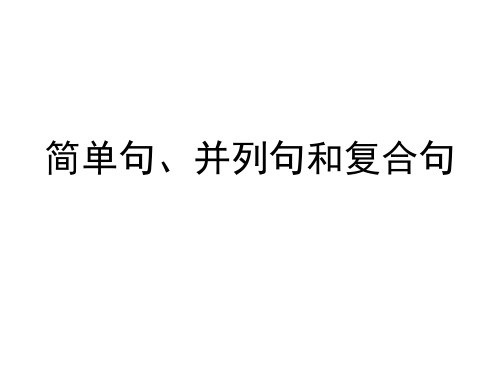
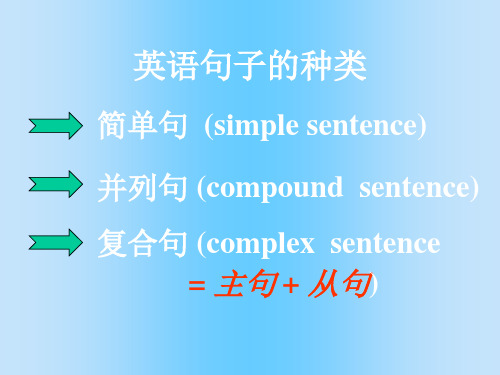
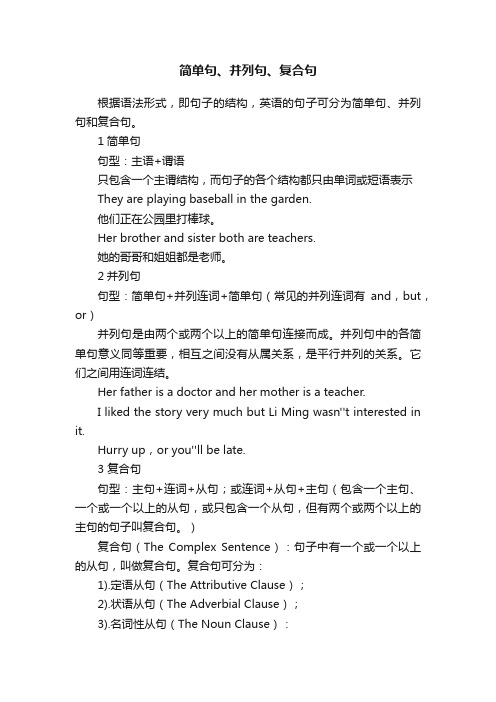
简单句、并列句、复合句根据语法形式,即句子的结构,英语的句子可分为简单句、并列句和复合句。
1简单句句型:主语+谓语只包含一个主谓结构,而句子的各个结构都只由单词或短语表示They are playing baseball in the garden.他们正在公园里打棒球。
Her brother and sister both are teachers.她的哥哥和姐姐都是老师。
2并列句句型:简单句+并列连词+简单句(常见的并列连词有and,but,or)并列句是由两个或两个以上的简单句连接而成。
并列句中的各简单句意义同等重要,相互之间没有从属关系,是平行并列的关系。
它们之间用连词连结。
Her father is a doctor and her mother is a teacher.I liked the story very much but Li Ming wasn''t interested in it.Hurry up,or you''ll be late.3 复合句句型:主句+连词+从句;或连词+从句+主句(包含一个主句、一个或一个以上的从句,或只包含一个从句,但有两个或两个以上的主句的句子叫复合句。
)复合句(The Complex Sentence):句子中有一个或一个以上的从句,叫做复合句。
复合句可分为:1).定语从句(The Attributive Clause);2).状语从句(The Adverbial Clause);3).名词性从句(The Noun Clause):一、定语从句定语从句的定义定语从句在句子中作定语,用来修饰一个名词、名词词组或者代词。
先行词和引导词被修饰的名词、名词词组或代词叫做先行词;在先行词和定语从句之间起连接作用的词叫做引导词。
引导词分为“关系代词”和“关系副词”。
关系代词和关系副词关系代词有:who, whom, whose, that, which, as。
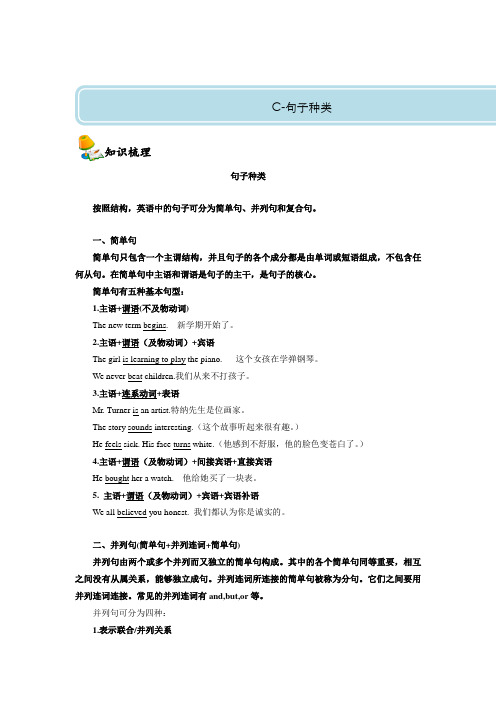
C-句子种类知识梳理句子种类按照结构,英语中的句子可分为简单句、并列句和复合句。
一、简单句简单句只包含一个主谓结构,并且句子的各个成分都是由单词或短语组成,不包含任何从句。
在简单句中主语和谓语是句子的主干,是句子的核心。
简单句有五种基本句型:1.主语+谓语(不及物动词)The new term begins. 新学期开始了。
2.主语+谓语(及物动词)+宾语The girl is learning to play the piano. 这个女孩在学弹钢琴。
We never beat children.我们从来不打孩子。
3.主语+连系动词+表语Mr. Turner is an artist.特纳先生是位画家。
The story sounds interesting.(这个故事听起来很有趣。
)He feels sick. His face turns white.(他感到不舒服,他的脸色变苍白了。
)4.主语+谓语(及物动词)+间接宾语+直接宾语He bought her a watch. 他给她买了一块表。
5. 主语+谓语(及物动词)+宾语+宾语补语We all believed you honest. 我们都认为你是诚实的。
二、并列句(简单句+并列连词+简单句)并列句由两个或多个并列而又独立的简单句构成。
其中的各个简单句同等重要,相互之间没有从属关系,能够独立成句。
并列连词所连接的简单句被称为分句。
它们之间要用并列连词连接。
常见的并列连词有and,but,or等。
并列句可分为四种:1.表示联合/并列关系用连词或逗号、分号连接构成并列句。
常用连词有:and, not only...but also..., neither...nor...Susan not only runs fast, but also jumps high. 苏姗不但跑得快,而且跳得高。
I can neither swim nor skate. 我既不会游泳,也不会滑冰。

简单句、并列句和复合句的区别在英语中,句子根据句子结构可以分为:简单句、并列句和复合句。
你知道要怎么区别简单句、并列句和复合句吗?接下来,店铺跟你分享简单句、并列句和复合句的区别方法。
如何区分简单句、并列句和复合句简单句、并列句和复合句的区别一、简单句当一个句子只包含一个主谓结构时,我们称之为简单句。
The train(主语) has just touched down(谓语).在英语中,最基本的句型大体上有五种。
1. S+Vi:主语+不及物动词She sat down beside me.2. S+V+P:主语+系动词+表语Mother isn't in at the moment.3. S+Vt+O:主语+及物动词+宾语I hope to finish the work today.4. S+Vt+OI+OD:主语+及物动词+间接宾语+直接宾语My uncle gave me a camera.5. S+Vt+O+C:主语+及物动词+宾语+宾语补足语The news made us sad.备注:S:主语Vi:不及物动词Vt:及物动词O:宾语OD:直接宾语OI:间接宾语C:宾语补足语二、并列句两个或两个以上独立的主谓结构或简单句并列在一起,我们称之为并列句。
各个简单句间是平行并列的关系,而非从属关系。
并列句的各个分句间可用逗号、分号、起连接作用的副词或并列连接词来连接。
1. 能连接并列句的连词and(和,又),but(但是),for(因为),however(然而),or(或者),so(所以,因而),while(然而),yet(然而)2. 能连接并列句的复合连词or else(否则,要不然),either...or...(要么···,要么···;或者···,或者···),neither...nor...(既不···,也不···),not only...but also(不仅···,而且···)3. 能连接并列句的副词besides(而且,还有),hence(因此),otherwise(否则,要不然),then(然后,于是),therefore(因此,所以),thus(因而,从而) 根据并列分句之间的不同关系,并列句则可以分为以下四种。


二、简单句、并列句和复合句(一)句子种类两种分类法1、按句子的用途可分四种:1)陈述句(肯定、否定):He is six years old; She didn't hear of you before.2)疑问句(一般、特殊、选择、反意):Do they like skating? How old is he? Is he six or seven years old? Mary can swim, can’t she?3)祈使句:Be careful, boys; Don't talk in class4)感叹句:How clever the boy is!2、按句子的结构可分三种:1)简单句:只有一个主语(或并列主语)和一个谓语(或并列谓语)。
e。
g. He often reads English in the morning。
Tom and Mike are American boys。
She likes drawing and often draws pictures for the wall newspapers.2)并列句:由并列连词(and, but, or等)或分号(;)把两个或两个以上的简单句连在一起构成.e。
g. You help him and he helps you。
The future is bright; the road is tortuous。
前途是光明的,道路是曲折的。
3)复合句:含有一个或一个以上从句的句子。
复合句包含:名词性从句(主语从句、宾语从句、表语从句和同位语从句)、定语从句和状语从句等。
e。
g. The foreign visitors took a lot of pictures when they were at the Great Wall。
(二)简单句的五种基本句型1、主语+系动词+表语:e.g. He is a student。
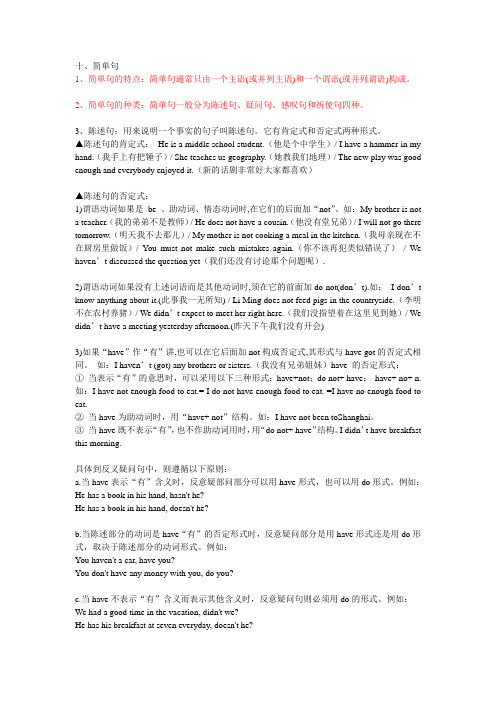
十、简单句1、简单句的特点:简单句通常只由一个主语(或并列主语)和一个谓语(或并列谓语)构成。
2、简单句的种类:简单句一般分为陈述句、疑问句、感叹句和祈使句四种。
3、陈述句:用来说明一个事实的句子叫陈述句。
它有肯定式和否定式两种形式。
▲陈述句的肯定式:He is a middle school student.(他是个中学生)/ I have a hammer in my hand.(我手上有把锤子)/ She teaches us geography.(她教我们地理)/ The new play was good enough and everybody enjoyed it.(新的话剧非常好大家都喜欢)▲陈述句的否定式:1)谓语动词如果是be 、助动词、情态动词时,在它们的后面加“not”。
如:My brother is nota teacher.(我的弟弟不是教师)/ He does not have a cousin.(他没有堂兄弟)/ I will not go there tomorrow.(明天我不去那儿)/ My mother is not cooking a meal in the kitchen.(我母亲现在不在厨房里做饭)/ You must not make such mistakes again.(你不该再犯类似错误了)/ We haven’t discussed the question yet(我们还没有讨论那个问题呢).2)谓语动词如果没有上述词语而是其他动词时,须在它的前面加do not(don’t).如:I don’t know anything about it.(此事我一无所知) / Li Ming does not feed pigs in the countryside.(李明不在农村养猪)/ We didn’t expect to meet her right here.(我们没指望着在这里见到她)/ We didn’t have a meeting yesterday afternoon.(昨天下午我们没有开会)3)如果“have”作“有”讲,也可以在它后面加not构成否定式,其形式与have got的否定式相同。
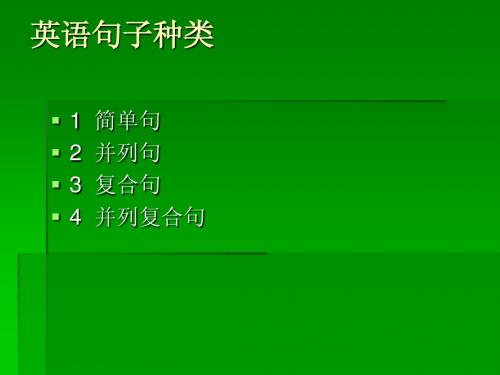

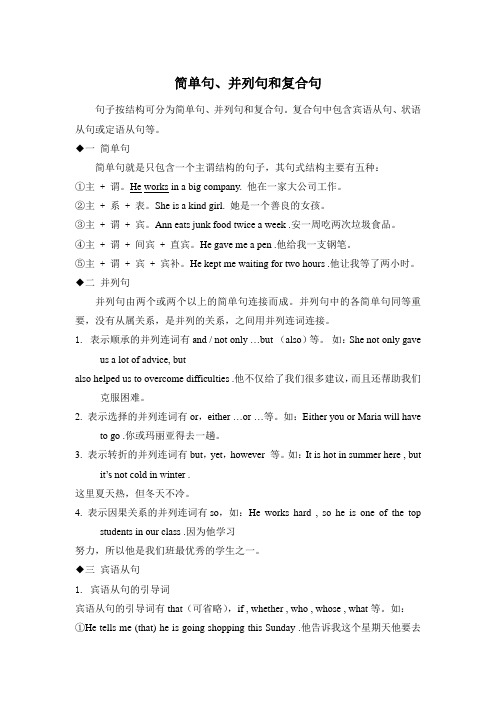
简单句、并列句和复合句句子按结构可分为简单句、并列句和复合句。
复合句中包含宾语从句、状语从句或定语从句等。
◆一简单句简单句就是只包含一个主谓结构的句子,其句式结构主要有五种:①主 + 谓。
He works in a big company. 他在一家大公司工作。
②主 + 系 + 表。
She is a kind girl. 她是一个善良的女孩。
③主 + 谓 + 宾。
Ann eats junk food twice a week .安一周吃两次垃圾食品。
④主 + 谓 + 间宾 + 直宾。
He gave me a pen .他给我一支钢笔。
⑤主 + 谓 + 宾 + 宾补。
He kept me waiting for two hours .他让我等了两小时。
◆二并列句并列句由两个或两个以上的简单句连接而成。
并列句中的各简单句同等重要,没有从属关系,是并列的关系,之间用并列连词连接。
1. 表示顺承的并列连词有and / not only …but (also)等。
如:She not only gaveus a lot of advice, butalso helped us to overcome difficulties .他不仅给了我们很多建议,而且还帮助我们克服困难。
2. 表示选择的并列连词有or,either …or …等。
如:Either you or Maria will haveto go .你或玛丽亚得去一趟。
3. 表示转折的并列连词有but,yet,however 等。
如:It is hot in summer here , butit’s not cold in winter .这里夏天热,但冬天不冷。
4. 表示因果关系的并列连词有so,如:He works hard , so he is one of the topstudents in our class .因为他学习努力,所以他是我们班最优秀的学生之一。
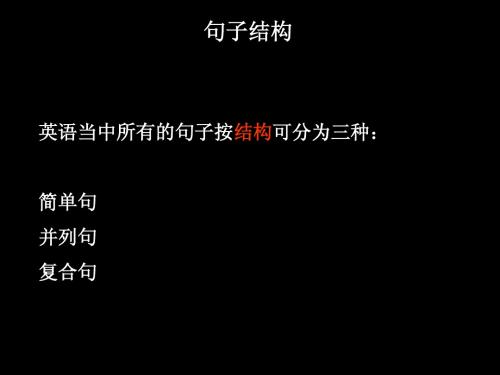

简单句、并列句、复合句、并列复合句文章来源:互联网在前面各讲中所说的肯定句、否定句、各种疑问句、感叹句等,是根据句子的作用来划分的。
今天,我们再学习一种新的分类方法:即根据句子的内部结构,特别是句子与句子之间的关系来划分的方法。
根据句子结构,可以分为三种主要类型:简单句、并列句、复合句,另外还有一种叫并列—复合句子.要搞懂英语句子结构分类,有一点首先必须明白:即什么是“句子"?句子的概念有两层含义:一是它能表达一个清晰、完整的意思。
反过来讲,只要能表达一个清晰、完整的意思的语言单位,不论是长是短,哪怕是一个单词,也算作是一个句子。
这是从意义方面来说的.二是句子的结构完整。
所谓“完整”,最核心的是一个句子应该有“主语、谓语”.也就是说,有主语、有谓语的语言单位就是一个句子。
这就是从句子结构方面来分的,也是从句子语法成份方面来划分的。
我们所讲的简单句、并列句、复合句都是从主语、谓语来判定句子类型的。
如果按照句子的结构分类,英文句子可分为三种类型:简单句(Simple Sentence),并列句(Compound Sentence)和复合句(Complex Sentence).一、简单句简单句的定义是:或者只有一个主语,或者只有一个谓语.为什么说“或者”呢?因为简单句可以只有一个主语,但有几个谓语;或者可以有几个主语,但只有一个谓语。
这样一分,简单句就有三种形式了。
1、只有一个主语、一个谓语,再加上其它成份。
例如:Light travels faster than sound.光比声传播速度快。
The film is not interesting。
这部电影没有意思。
Can you finish the work on time?你能按时完成工作吗?2、只有一个主语,但有几个谓语,再加上其它成份。
例如:The boy were running, shouting and laughing.男孩们一边跑,一边笑,一边喊叫着。

句式句型专题(五):简单句、并列句、复合句句子按其结构可以分为以下三类:1)简单句(Simple Sentences):只包含一个主谓结构句子叫简单句,例如:She is fond of collecting stamps.她喜欢集邮。
2)并列句(Compound Sentences):包含两个或两个以上主谓结构的句子叫并列句,句与句之间通常用并列连词或分号来连接,例如:The food was good, but he had little appetite.食物很精美,但他却没什么胃口。
一.概念(一)简单句 由一个主语(或并列主语)和一个谓语(或并列谓语)所构成的句子叫简单句,其结构是主语+ 谓语。
She is fond of collecting stamps.她喜欢集邮。
五种基本句型(Basic Sentence Patterns):英语中千变万化的句子归根结底都是由以下五种基本句型组合、扩展、变化而来的:1)主+ 动(SV)例如:I work.我工作。
2)主+ 动+ 表(SVP)例如:John is busy.约翰忙。
3)主+ 动+ 宾(SVO)例如:She studies English.她学英语。
4)主+ 动+ 宾+ 补(SVOC)例如:Time would prove me right. 时间会证明我是对的。
5)主+ 动+ 间宾+ 直宾My mother made me a new dress.我母亲给我做了一件新衣裳。
(二)并列句 由并列连词把两个或两个以上的互相关连而又互相独立的独句(即简单句)连在一起而构成的句子叫并列句。
其结构是:简单句+并列连词+简单句常用的连词有and, but, or not only...but also, neither...nor, either...or并列句分为:联合并列句, 转折并列句, 选择并列句和因果并列句联合并列句常由并列词and, not only…but also…..等连接如: Use your hand, and you’ll find a way.转折并列句常由并列连词but, while, yet, whereas, nevertheless等连接如:I would love to have gone to the party last night but I had to work extra hours to finish a report.选择疑问句常由并列连词or, otherwise, either…or…, 等连接如:Either you leave this house or I’ll call the police因果并列句由并列连词so, for, therefore 等连接.如: it was late, so we went home.在”祈使句+and/or+陈述句”结构中, 当前后两部分间为承接关系时, 用and;前后意思为相反关系时, 用or.可将前面的祈使句转换成由if引导的条件状语从句, 但必须将and 或or 去掉.如: Hurry up, and we’ll be there in time.= If we hurry up, we’ll be there in time. because和so; although, though和but 不能连用3)复合句(Complex Sentences):包含一个主句从句和一个或几个从句的句子叫复合句,从句由从属连词或关系代词引导,从句分为定语从句、名词性从句和状语从句.例如:The news that our women volleyball team had won the championship encouraged us all greatly. 我们女排赢得冠军的消息大大地鼓舞了我们所有人。
(名词性从句)A man who doesn't learn from others can't achieve much.一个不向别人学习的人是不能有多少成就的。
(定语从句)The film had begun when we got to the cinema.(状语从句)主句从句我们到达电影院的时候,电影已经开演了。
定语从句概念:1.在句子中修饰名词或代词,定语从句在句中充当定语.2.定语从句必须有先行词,并尽量靠近先行词.3.在定语从句中,关系代词在从句中充当主干成分.关系代词与关系副词关系代词:指人:who(主/宾),whom(宾),whose(定语,所有格)指物:which(主格,宾格),whose(定语,所有格)指人或物:that关系副词: when, where, why一、关系代词的用法1.that和which的用法(1)限制性定语从句中,必须用关系代词that的情况:①当先行词是不定代词all,much,little,something,everything,anything,nothing,none,the one时。
You should hand in all that you have.②当先行词前面被the only,the very,any,few,little,no,all等词修饰时。
This is the only thing that has been tried.③当先行词是形容词最高级或先行词的前面有形容词最高级修饰时。
This is the best that has been used against pollution.④当先行词是序数词或它前面有序数词修饰时。
This train is the last that will go to Suzhou.⑤当先行词既有人又有物时。
Do you know the things and persons that they are talking about?⑥当主句的主语是疑问词who或which时。
Which is the bike that you lost?⑦有两个定语从句时,其中一个关系代词已用which,另外一个宜用that。
They secretly built up a small factory,which produced things that could cause pollution.(2)定语从句中必须用which的情况:①在非限制性定语从句中,只用which,不用that。
Helen was much kinder to her youngest son than to the others,which,of course,made the others envy him.②当动词短语中的介词提前时,只用which,不用that。
This is a house in which Lu Xun once lived.2.“介词+关系代词”引导的定语从句“介词+关系代词”引导定语从句时,关系代词只能用which(指物)或whom(指人),即:介词+which/whom。
They may start as a group of high-school students,for whom practising their music in someone’s house is the first step to fame.He lived in a big house,in front of which stood a big tall apple tree.3.as和which的区别(1)as引导的非限制性定语从句,既可在主句前,又可在主句后,有时还可插入主句中,而which引导的非限制性定语从句只能置于主句之后。
相同的是两者都可替代主句的整个内容,而不是主句中的某一个词。
The weather turned out to be very good,which was more than we could expect.(2)当非限制性定语从句放在主句前面时,只能用as。
As is known to everybody,the moon travels round the earth once every month.二、关系副词的用法1.当先行词在定语从句中作状语时,要用关系副词。
I still remember the day when I first came to Beijing.(when=on which)Can you tell me the office where he works?(where=in which)2.介词+关系代词(which)=where/when。
有时为表达清楚,还可以在关系副词where/when前加介词from,to等。
China is the birthplace of kites,from where kites spread to Japan and Korea.3.高考对关系副词where的考查。
高考试题中对于where的考查趋于复杂,从先行词为明显的“地点”转为“地点的模糊化”。
事实上,对于where这个词,考生不能只理解为表地点。
当先行词表示某人/物的situation,或某事所发展的stage,或表达某事的某个方面时都可用where这个关系副词。
The accident has reached to a point where both their parents are to be called in.1.Stephen Hawking believes that the earth is unlikely to be the only planet________life has developed gradually.(2010·福建,24)A.that B.where C.which D.whose 2.The girl arranged to have piano lessons at the training centre with her sister________she would stay for an hour.(2010·江西,31)A.where B.who Cwhich D.what 3.That’s the new machine________parts are too small to be seen.(2010·山东,A.that B.which C.whose D.what4.—Can you believe I had to pay 30 dollars for a haircut?—You should try the barber’s________I go.It’s only 15.(2010·天津,8)A.as B.which C.where D.that5.The old temple________roof was damaged in a storm is now under repair.(2010·陕西,11)A.where B.which C.its D.whose6. Some experts think reading is the fundamental skill upon______ schooleducation depends. (2015安徽28)A. itB. thatC. whoseD. which7. He wrote many children’ s books, nearly half of____ were publis hed in the1990s. (2015重庆14)A. whom B. which C. them D. that8. Opposite is St.Paul’s Church, _____you can hear some lovely music.(2015北京24)A. whichB. thatC. whenD. where9. It is a truly delightful place, ________ looks the same as it must have done 100years ago with its winding streets and pretty cottages.. (2015湖南29)A. asB. whereC. thatD. which10. The number of smokers, ________is reported, has dropped by 17 percent injust one year. (2015江苏21)A. itB. whichC. whatD. as11. Creating an atmosphere________ employees feel part of a team is a bigchallenge. (2015浙江19)A. asB. whoseC. in whichD. at which12. The boss of the company is trying to create an easy atmosphere ______ hisemployees enjoy their work. (2015天津15)A. whereB. whichC. whenD. who13. The books on the desk, ______ covers are shiny, are prizes for us. (2015四川3)A. whichB. whatC. whoseD. that14. As the smallest child of his family, Alex is always longing for the time______ he should be able to be independent. (2015陕西15)A. whichB. whereC. whomD. when15. China Today attracts a worldwide readership,_______ shows that more andmore people all over the world want to learn about China. (2015福建34)A. whoB. whomC. thatD. which1.It is morning ________ we have four classes,not afternoon.A.when B.which C.that D.why 2.Thousands of Haitians cheered as the Chinese medical team arrived,many of ________ even cried with joy.A.those B.them C.whom D.who 3.He saw her coming,and advised me to hide behind the door,________ adviceI took at once.A.whose B.what C.that D.which4.On the top of the mountain stands an old temple,inside ________ is an old tower.A.what B.that C.which D.where 5.The National Education Department says school safety has set off alarm bells with frequent serious accidents ________ students got injured or even killed. A.that B.in which C.by which D.when。